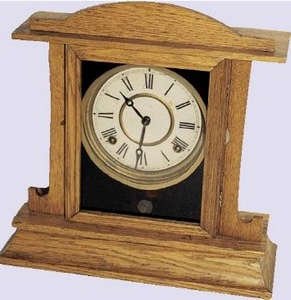Elias Ingraham (1805-1885) founded the E. Ingraham Company. He served a five-year apprenticeship with Daniel Dewey as a cabinetmaker. In 1828 he went to work for George Mitchell, a wise businessman inBristol,Connecticut. Mitchell wanted a worker who was creative and could produce new case styles. By succeeding in this task, Ingraham earned the reputation of being an innovative man in the clock industry. The exotic case he designed had mahogany columns, paw feet, turned rosettes, and carved baskets of fruit.
In 1830 Ingraham went to work for Chauncey and Lawson C. Ives to design cases for their clocks. One of his cases, which could accommodate a long drop of weights, was a triple-decker. In the three years that followed, Ingraham made almost six thousand cases for Chauncey and Lawson C. Ives.
E. Ingrahain oak kitchenette shelf clock, eight-daytime & strike, ca. 1930,13 1/2 x 13 i/2″h. $150
During the next ten years, Ingraham made clock cases, chairs, and mirrors. He helped design a Gothic case, named a steeple clock, which became extremely popular. These smaller clocks rapidly replaced the large Empire-style cases.
In the mid-l840s, he formed a partnership called Brewster and Ingraham. Members of the clock making company were Elisha Brewster and the Ingraham brothers, Elias and Andrew. The Ingraham Company, with its various name changes and partners, became one of the world’s largest clockmakers.
In 1855, the Ingraham factor}’ inBristolburned, resulting in a loss of about $30,000. Elias Ingraham formed a new company when he made his son Edward a partner in 1857. They used the name E. Ingraham & Company from 1861 to 1880. In 1881, they added the word “The” to the name to make it The E. Ingraham & Company. This name stayed as such until 1884, when “&” was dropped to make it simply, The E. Ingraham Company. During this period, the company manufactured clocks with black-painted or japanned cases. Over two hundred different models were built.
From 1914 to 1942, some of the company’s products included non-jeweled pocket watches, wrist watches, eight-day lever movement clocks, electric clocks, and pendulum clocks.
When the company was sold to McGraw-Edison in 1967, clockmaking ceased inBristol.

